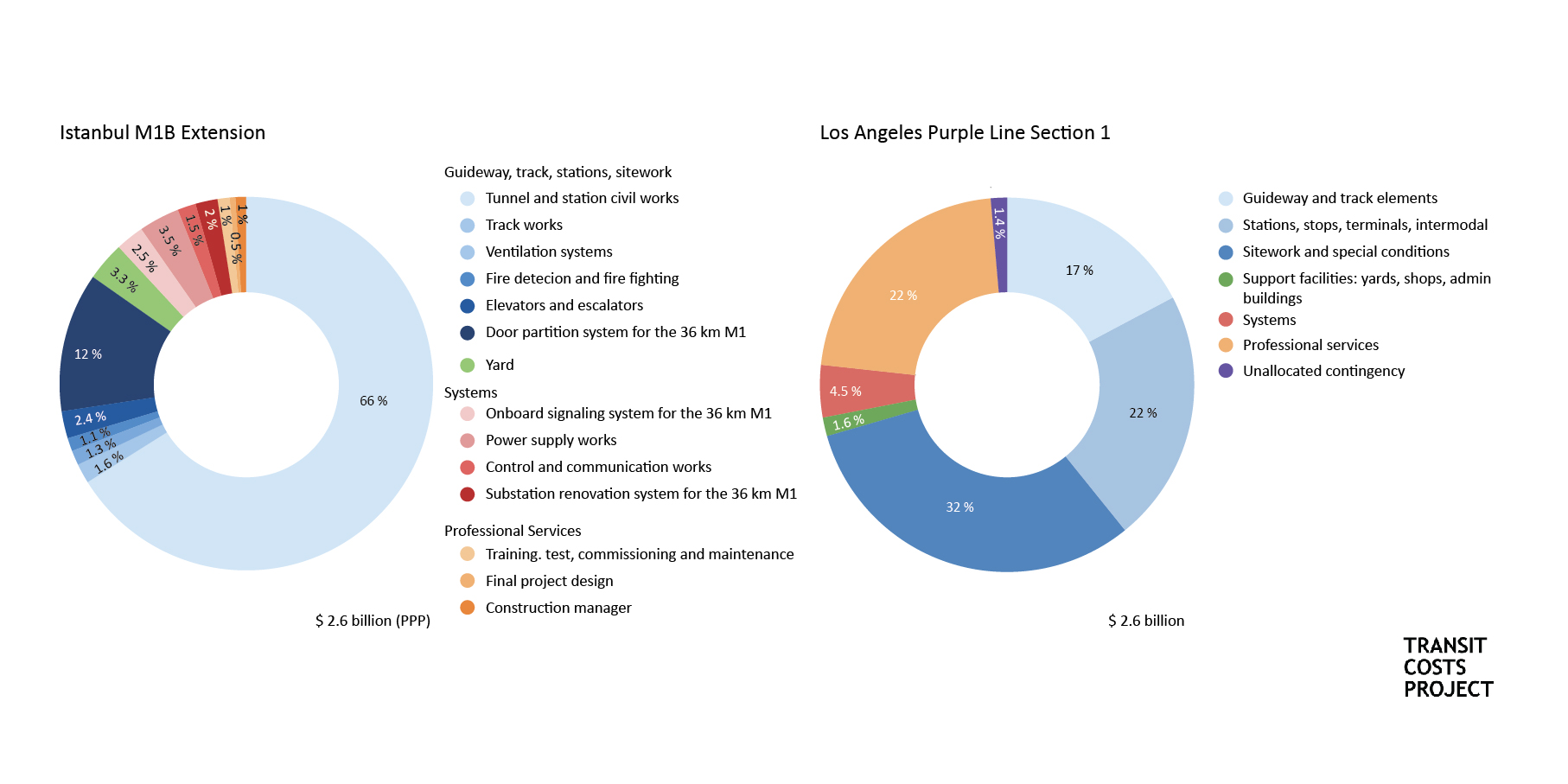Istanbul M1B – LA Purple Line Comparison

In order to compare costs across different contexts, we decided to take a few projects and compare them side by side. Rather than looking solely at headline costs, we are examining multiple variables at a finer scale, such as urban context, platform length, financing, systems, construction method, number of stations, hard and soft costs, etc. Below is our first attempt to compare two projects. We selected Istanbul’s M1B and Los Angeles’ Purple Line Extension Section 1 because they share similar construction methods, project timelines, platform lengths, and costs. Despite these similarities, they also diverge in important ways; thus, they aren’t perfect analogues. We believe, however, that even though geology, work rules, and wages differ from country to country, it’s still important to compare different projects and uncover what drives costs.
Istanbul’s M1B Extension and Los Angeles’ Purple Line Extension Section 1 are similar in that:
- Both are extension projects in dense urban settings
- Both incorporate TBM tunnel work
- They have similar platform sizes: M1B 125m (410ft) vs. Purple Line 140m (450ft)
- Their total costs for construction and professional services are very similar ($2.6 billion) The overall costs for the Purple Line Extension Section 1 add up to $3.3 billion as of 2021, which include financing, right of way, land and existing improvements, and unallocated contingency
- Their projected construction timelines are both 10 years (PL S1 2014-2024, M1B 2017-2027)
The main differences between the two projects are:
- M1B is 9.7 kilometers (6 miles) long and includes 9 new stations, Purple Line Section 1 is 6.3 kilometers (3.9 miles) and 3 stations
- M1B’s budget includes additional costs like the renovation of all substations and the signaling of the complete M1 line that is 36 kilometers long
- M1B incorporates some aerial elements including the Halkali Station, but the total TBM tunnel lengths are similar
- Purple Line Extension Section 1 started out with a budget of $2.8 billion, but has incurred overruns bringing the estimated budget to $3.3 billion. M1B’s construction contract of $2.2 billion (PPP adjusted value) allows for a maximum 20% budget increase. It is expected the contract value will increase upon completion of the project, as the contract was awarded in Turkish Lira, which has lost 70% of its value against the Dollar since 2017. So the final budget is expected to increase from $2.6 to $3 billion (PPP adjusted).
The differences in the budget allocations are:
- The majority of both projects’ budget is allocated to guideway, track elements and stations:
M1B: $2.3 billion, 88% of the complete budget, Purple Line P1: $1.9 billion, 72% (note the difference in length and # of stations).
- Systems costs make up 9.5% of M1B’s and 4.6% of Purple Line’s costs. Turkey usually imports systems expertise from Europe, so these costs are relatively higher, but for this project, onboard signaling systems and platform screen doors were procured locally, from Aselsan (75% owned by the Turkish Armed Forces Foundation), Tubitak (Scientific and Technological Research Council of Turkey) and Metro Istanbul (government owned operating company of Istanbul metros). This is a recent example of developing local expertise. By procuring domestically, Istanbul Metropolitan Municipality (IMM) reduced the costs of these items by 40%. (Note that we refer to the power supply and traction, control and communication as well as the signaling and substation renovation works of the complete 36 kilometer line as the Systems costs making up 9.5% of Istanbul’s M1B costs, also shown in the above chart.)
- Professional services cost $65 million, 2.5% for M1B and $572 million, 21.9% for the Purple Line. This difference is something we see routinely when we compare Turkish and American projects. Part of the difference stems from Turkey’s lower labor and white collar wages, but is also a product of the streamlined procurement methods that IMM follows which caps overruns at 20% of the construction contract’s value and relies on fewer consultants.
The right of way, land and existing improvement costs, financing costs, and rolling stock are not included in these breakdowns (we don’t have the information for the first two for Istanbul). M1B’s rolling stock is part of a larger 272-car $517 million ($1.7 billion PPP adjusted) order from CRRC for the full-length M1 line. LA Metro also ordered its Purple Line Extenson Section 1 rolling stock from CRRC. An initial order for 64 cars was placed, and it includes an option to order 218 more, which would make the total 272 cars at a cost of $647 million.
Financing charges for Istanbul projects are about 30-35% percent of the construction costs, which would come to $720 million for M1B making up 22% of the total budget whereas for the Purple Line Section 1, the financing costs are $375 million and make up 12.6% of the budget if included in the total. This difference is due to Turkey usually taking out loans from Europe with high interest rates. For this specific project, Istanbul utilized a new model introduced by the new governor and exported €580 million worth of Eurobonds to finance this project. We don’t have the financing costs information for this new model.

